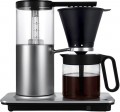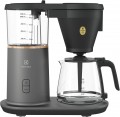Adjustments
—
Grinding degree. Choosing the degree of coffee grinding is crucial for achieving the desired strength and consistency of the final coffee. Different types of coffee drinks require varying degrees of grinding. For espresso and related drinks like cappuccino and latte, a fine grind is necessary. Turkish coffee requires an extremely fine grind, almost like "dust." Cream coffee and filter coffee are best with a medium grind, while a coarse grind works well for French press.
—
Pre-wetting. One option available in some coffee makers is the ability to pre-moisten the ground coffee with hot water before brewing the drink. This feature allows users to customize the duration of coffee wetting, although there may be exceptions. Pre-wetting plays a crucial role in enhancing the taste and aroma of coffee, resulting in a more intense and flavorful beverage. Automatic coffee makers often include this feature.
—
The strength of the drink. Coffee enthusiasts have the option to manually adjust the strength of their beverage. This adjustment can be achieved through various methods, such as changing the coffee-to-water ratio, adjusting the water temperature, or controlling the brewing speed. The number of available settings may vary, ranging from a basic choice between "strong" and "mild" to more advanced options. Regardless of the number of settings, this function allows
...individuals to personalize the taste of their coffee according to their preferences, providing additional customization features.
— Drink volume. Coffee makers offer the feature of selecting the desired volume of the final beverage according to individual preferences. Different models may have varying methods for making this choice. Some machines provide fixed settings (20 mL, 35 mL, etc.) from hich users can select their preferred option. Other models allow for manual adjustment of the volume, sometimes even allowing users to gauge it visually. This feature enables users to customize standard programs to their liking and provides opportunities for experimenting with unique recipes.
— Temperature control. Coffee makers offer the ability to regulate the water temperature for brewing coffee. The taste of the final beverage is heavily influenced by this factor. Higher temperatures result in a brighter and more intense flavor, but excessive heating (96 °C and above) can release compounds from the coffee that add bitterness. The optimal brewing temperature is generally considered to be within the range of 92 — 95 °C. However, coffee makers may provide a wider range of temperature adjustments. Some believe that even a difference of just 1 °C can significantly impact the properties of the coffee, making this adjustment essential for those who appreciate the subtle nuances of taste and aroma in their coffee.
— Steam pressure. Coffee makers offer the feature to adjust the steam pressure coming out of the panarello nozzle. This nozzle is used for frothing milk, especially when preparing cappuccino, as well as for heating milk. By modifying the steam outlet pressure, users can control the intensity of the steam and achieve varying foam densities. It also allows them to omit foam altogether if the intention is solely to heat the milk.
— Foam volume / density. For coffee and milk beverage enthusiasts, the ability to adjust the volume and thickness of the foam "cap" is highly useful. This feature is particularly valuable when preparing drinks like cappuccino, latte, and macchiato. The quality of the final beverage is influenced by the quantity and density of the foam. By customizing these parameters, users can tailor the drink to their personal taste preferences.
— Water hardness. Coffee makers offer the capability to adjust the settings based on the hardness of the water being used. Over time, the heating element of the coffee machine accumulates scale and requires regular cleaning or descaling. The rate of scale buildup increases with harder water, necessitating more frequent cleaning. However, the coffee machine evaluates the condition of the heating element not based on the actual scale amount, but by considering the water hardness setting and the duration of operation since the last cleaning. Therefore, it is crucial to correctly set the water hardness settings to receive timely notifications for descaling. Coffee machines equipped with this feature often include a water hardness indicator with four settings: very soft, soft, hard, and very hard.Cups in one go
The number of cups of coffee that can be prepared in the coffee maker at one time.
The meaning of this characteristic may be different, depending on the design of the coffee maker. So, if the device does not belong to geyser models or electric Turks (see "Type"), and also does not have its own coffee pot (reservoir for finished coffee), the number of cups is indicated by the number of pouring spouts. Among such models, devices for two spouts, that is, for
two cups, have become widespread: they are convenient not only for preparing coffee for two people, but also for recipes that require a double portion of espresso. Options for
one spout are much less common, these are mostly compact and relatively inexpensive models.
In turn, for Turks and geyser coffee makers, the number of servings is determined by the capacity of the water tank (see below), and for models with their own coffee pot, by the capacity of the coffee pot (it also approximately corresponds to the capacity of the tank). Moreover, the counting is also carried out in different ways. In electric Turks, geyser models, as well as espresso coffee makers with a container for ready-made coffee, 60 g of drink is usually considered per portion — the maximum volume of one cup of classic espresso; for filtration models — twice as much, 120 – 125 g (standard portion volume of filter coffee). In all these cases, the number of cups can be
...href="/list/95/pr-2472/">three or more, and many coffee pots generally hold 10 — 12 portions.Water tank
The volume of the water tank provided in the coffee maker; for turkish electric coffee pot (see "Type"), this paragraph indicates the actual working volume of the turk.
The larger the tank, the more coffee you can make without refilling the device; on the other hand, a large capacity, respectively, affects the dimensions, weight and price of the device. Therefore, manufacturers select this parameter in accordance with the general level of the coffee maker and the features of its intended use. So, you rarely have to make more than two cups of coffee at the same time, and 300 – 400 mL for such cases is usually more than enough for home use. And for use in a coffee shop or restaurant, where coffee is made often and in large quantities,
large-sized devices are produced, the volume of which is already calculated in liters; recommendations for choosing the volume of a coffee maker for professional use can be found in special sources.
Power consumption
Power consumption of the coffee maker. Usually, this indicator is comparable with the power of the heater installed in the device.
This parameter is selected by the manufacturer, taking into account other performance characteristics (type of device, tank volume, additional functions, etc.), so that the coffee maker can effectively cope with its tasks. Therefore, in fact, power is of secondary importance: it is worth deciding first of all on other practical points, and only then look at power when choosing. In general, a more powerful coffee maker (ceteris paribus) will quickly cope with the preparation of coffee, but it will also cost more.

